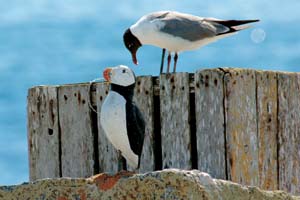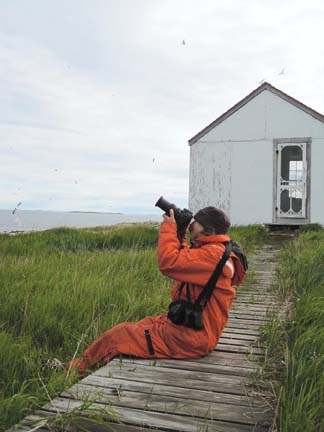 |
 |
| current issue |  |
past issues |  |
send a letter/news |  |
address update |  |
advertise |  |
about us |  |
alumni home |
Features
|
For the Love of Birds
"Seabird Sue" has devoted her career to bringing back rare seabirds by Suki Casanave '86G |
Easy to print version |
 |
It's hard to know exactly when a puffin chick will be ready to fledge--and nearly impossible to witness--but if you happen to be spending the summer on one of the few uninhabited islands off the coast of Maine where these seabirds nest, and if you happen to be sleeping out under the stars on a night in early August, and if you happen to be awake at precisely the right moment, you just might hear a flurry of wings, a scrambling of little feet. And then, you might actually see the chick emerge from its burrow and tear furiously across the rocks heading straight for the sea. If you happen to be Susan Schubel '84, you might even find that the puffin, in its instinctual mad dash to destiny, runs right over your sleeping bag.
A wildlife biologist with National Audubon's Seabird Restoration Program and Project Puffin, Schubel spent her first summer among the birds more than 20 years ago. She was instantly hooked. "It was something I was craving all my life--to live in an environment that is not dominated by humans," says Schubel, whose childhood hero was Marlin Perkins, host of "Wild Kingdom," the popular television series. "I loved being out in this thriving bird colony, all this living and dying, so much action and vitality."
 Sue Schubel '84 holds a laughing gull fledgling. Puffin decoys, like the one at left, helped re-establish puffin colonies. Far left, a puffin egg in an island nest. |
For years afterwards, Schubel spent every summer working on one of Audubon's seven Maine island sanctuaries, sometimes alone, sometimes with a couple of other scientists. Her world was a rocky, treeless outpost, surrounded by sea. And birds. She didn't mind the constant calling of the gulls, the severe weather, the isolation. She didn't even mind the fact that most of the time she was covered with bird poop. Or the oily, fishy vomit that came up when an adult bird she was handling was nervous. It was all part of being Seabird Sue, the name she's earned through the years for her passionate love of her work.
 BIRD'S EYE VIEW: Sue Schubel '84, recipient of a 2008 Disney Wildlife Conservation Hero award, on Matinicus Rock. |
"Not everybody can handle this kind of extreme environment," says Steve Kress, founder and director of the Seabird Restoration Program and Project Puffin. "Sue was out there for years, summer after summer, happy to spend the whole season, never wanting to leave the island." Most volunteers rotated on and off the job every couple of weeks, ready for a break. Not Schubel. For her, it was the perfect life. She sometimes caught pollack and mackerel for dinner or concocted meals from mussels, snails and seaweed. Once, she pulled up a dogfish shark using a hook she had created from a bent nail. She loved building bird blinds and making repairs to the tiny shack she lived in. Falling asleep to the night music of the island, the low murmuring call of the petrels in their burrows, was her idea of heaven.
Schubel met Kress thanks to UNH's legendary ornithology professor, Art Borror, who taught one of her favorite classes and shared her love of puffins. When Borror told her about a scholarship to attend Audubon's Hog Island summer camp in Bremen, Maine, where Kress was director, she jumped at the chance to apply. She knew that Kress, whom she remembered from a "Wild Kingdom" episode, was leading a now-famous effort to re-establish a puffin colony on Eastern Egg Rock, just a few miles from Hog Island. Once plentiful along the coast of Maine, the birds were popular in the 19th century for their feathers, meat and eggs, and were hunted nearly to extinction. By the time Kress launched his project in 1973, only two colonies remained.
Page: 1 2 3 Next > blog comments powered by Disqus
